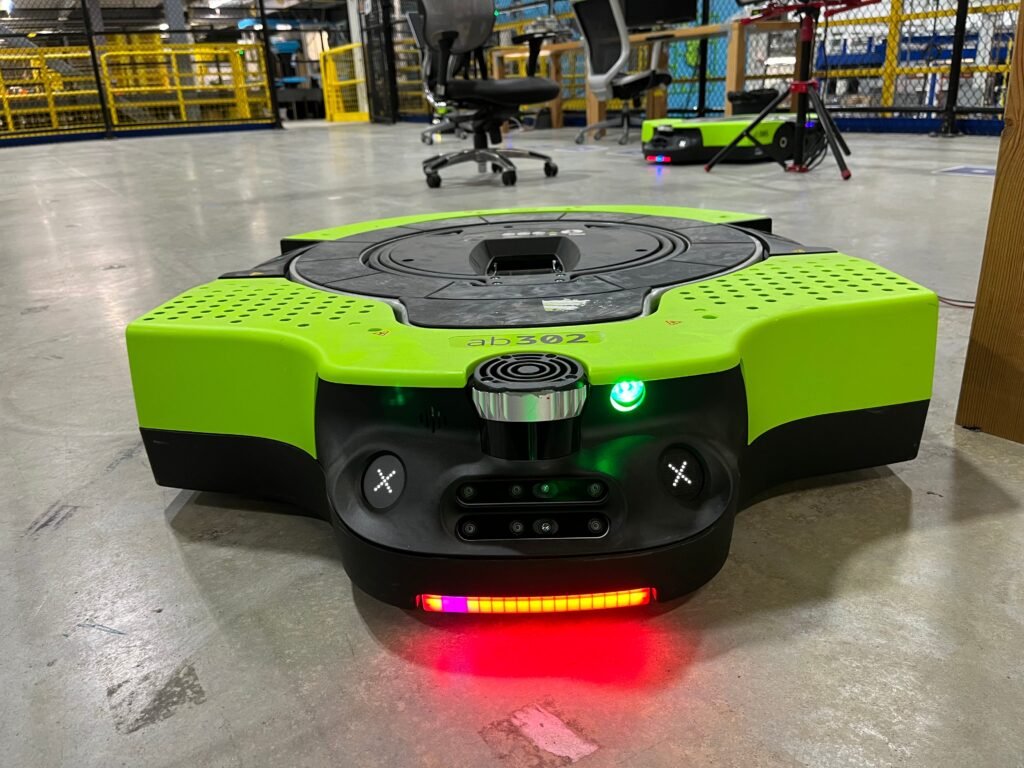I visited Amazon’s robot factories and got an inside look at how it builds and trains them

Madeline Stone
- Amazon has invested heavily in robotics and automation for its fulfillment centers.
- Its robots include mobile units, robotic arms, and sortation systems.
- Business Insider got an inside look at how the robots are made in facilities outside Boston.
Amazon is making big bets on robotics and automation.
What started with its $775 million acquisition of Kiva Systems in 2012 has grown to include a fleet of more than 750,000 robots and an operation that employs more than 16,000 people.
“We have really pioneered new work and allowed Amazon to be more productive and take care of our frontline employees by improving the safety bar,” Tye Brady, chief technologist at Amazon Robotics, said.
I recently got to see the facilities in North Reading and Westborough, Massachusetts, where Amazon builds and tests its warehouse robots. It was a sprawling look at what modern manufacturing looks like in the US.
Take a look inside:
Madeline Stone
The green one at the front is Amazon’s latest mobile drive unit, Proteus, which can sense objects and humans in its path and move around them. The robots get older the further along the line you go.
Madeline Stone / BI
The blue robots, called Hercules, move pods of items around a fenced area of a fulfillment center. Each Hercules robot can lift a pod that weighs up to 1,250 pounds. The green robots, called Proteus, do similar tasks but move autonomously.
The North Reading facility was previously home to Kiva Robotics before Amazon acquired the company in 2012.
Madeline Stone
She said that Amazon works with teams in its fulfillment centers to understand which areas could be made more efficient with automation. Robots go through early alpha testing and then beta testing before they are ready for mass production.
“We work backwards from our customer needs and think about which systems will help enable better delivery and faster speeds to our customers,” she said. “We look to try to develop systems that will add value within one to two years in our fulfillment network.”
Madeline Stone
On the middle floor are Pegasus robots, which transport packages around sortation centers.
The yellow robotic arm below is Robin, which uses suction to pick up packages.
Madeline Stone
They zoomed around the floor, testing out new software updates.
The Pegasus robot is an evolution of the Hercules robot, using the same base but with a conveyor belt on top. The orange robots are older, from before Amazon rebranded its Prime services to blue.
Madeline Stone
Proteus is designed to work alongside employees on a shipping dock. Those workers don’t get specific training to work with robots.
“It was really important to us to make Proteus intuitive to understand so the human-robot interaction is seamless,” Mitchell said. “We used the eyes as a way to communicate.”
Madeline Stone
Amazon has now built more than 750,000 mobile robots, in addition to its robotic arms and sortation systems.
Madeline Stone
About 300 people work on the physical side of building and maintaining Amazon’s robotic fleet. The majority of those employees are on the assembly line, while others receive and ship materials and test and repair robots.
“We’re in a very controlled, stable environment here, so we’re able to, for all of our new products, continuously look at how we optimize the entire flow,” McClosky said.
Madeline Stone
Amazon’s manufacturing stations have built-in automation, too, including torque tools.
“If you’re supposed to install, let’s say, four fasteners, it’ll make sure that you only store four fasteners and that it has the right rotation,” McClosky said.
Madeline Stone
“If there were ever to be a problem, we could trace back and understand what’s happening,” McClosky said.
Amazon sources its robotic parts globally as well as from some local suppliers.
Madeline Stone
The North Reading facility has four assembly lines with 10 stations each. Employees at each station complete their assembly tasks in about seven and a half minutes, using a lift assist for heavy items.
Madeline Stone
Amazon asked that I not take close-up photos of the robots without their covers on due to the sensitivity of the technology.
Madeline Stone
Lift assists are in place in various parts of the manufacturing process so that workers don’t strain to pick up heavy objects.
Madeline Stone
The robots’ batteries get charged to about 80% capacity before they are sent out to fulfillment centers.
Madeline Stone
She said that Amazon used to test its robots by filling big pods with bricks and having them drive around the factory floor for hours.
“What used to take us hours for testing here on the production floor is now done in minutes,” McClosky said. “It’s looking at environments that it would see in the fulfillment center, so under different loads, making sure that it is fully, fully functional.”
Madeline Stone
Proteus uses AI to “see” the space it’s navigating and decide whether it can safely navigate around an object or needs to stop moving forward.
Madeline Stone
“It’s kind of our workhorse in the fulfillment centers,” McClosky said.
Madeline Stone
No caps and gowns here — “graduating” just means they’re ready to be put to use.
Madeline Stone
Since Hercules can’t detect humans the same way that Proteus can, this is a restricted area.
Madeline Stone
They’ll be shipped using the loading docks seen in the background.
Madeline Stone
The packages I saw Robin pick up were all Amazon-branded, but the robot also frequently encounters packaging from third-party brands using Amazon’s fulfillment centers.
“We’re constantly using AI to train Robin to see different package types, different surfaces, different types of materials that it has to grasp,” Mitchell said. “We can change the way we grasp it by changing which actuator we send down to pick up the package. That helps cover the gamut of different shapes.”
Madeline Stone
Unlike Amazon’s other robots, Proteus doesn’t need to be kept in a fenced-off space away from people.
Madeline Stone
Cardinal works in conjunction with Proteus.
“When Cardinal finishes the stacking and creates a complete container, it will signal to Proteus to come and take that container and replenish that container,” Mitchell said. “The two robotic systems working together has created an end-to-end automated path from sorting to loading that container onto our trailers and our ship dock.”
Madeline Stone
I could feel the ground shake as Cardinal worked.
Madeline Stone
It’s located about 50 miles away, in Westborough, Massachusetts.
Madeline Stone
Amazon views this as a competitive advantage in that it allows for a more direct feedback loop. McClosky said that engineers and manufacturing staff work “shoulder to shoulder.”
Madeline Stone
It covers about 350,000 square feet of space.
Madeline Stone
He compared the way Amazon is thinking about robotics and physical AI to the way people thought about the computer in the 1950s.
“I think if you were to roll ahead in time, you’re going to see more and more physical AI agents used as tools to help people be more human, to help people be more capable of who they are, to allow people to connect to one another more readily,” he said.
Madeline Stone
Sequoia is a containerized storage system that brings pods over to a station where employees pick items out of totes so that they can be shipped to customers.
Madeline Stone
Brady said the items stored in each pod are somewhat random and chosen more so to fill the space. This is how Amazon has traditionally stored items, and it’s actually what the original Kiva system did even before it was part of Amazon.
Amazon’s newest robot, Vulcan, can pick from these pods using a sense of touch.
Madeline Stone
The totes have all kinds of goods, from water bottles to toys to Amazon Basics cables.
“This is where automation really helps us because we can take just about any object that fits inside one of these totes and place it in there,” Brady said.
A unique code on each tote helps keep track of what’s inside.
Madeline Stone
Brady explained how Sequoia helps workers in fulfillment centers to pick customers’ orders.
“When a customer goes on Amazon.com and they make an order, we look at the entirety of the Amazon network, we figure out which building has the goods closest to the customer, how we can make a meaningful delivery route for that customer, and then at the right time, we’ll call the right pod to a station where we can now have the goods that the customer has ordered inside this tote,” he said.
Madeline Stone
“I just pick the item out and then place it into another container to be packed and processed downstream,” he said.
Madeline Stone
Unlike the other robotic arms I saw earlier, Sparrow handles individual items rather than packages.
Madeline Stone
“The robotic system extracts the tote, presents it to the Sparrow arm,” Brady said. “That arm has its own end effector on it, and what it’s going to do is pick up objects and try to create a more full tote.”
Madeline Stone
It uses an AI system that looks down from above to differentiate between objects, look for damage, and determine the best path to place it into a bin.
“That’s really the holy grail when it comes to manipulation: being able to successfully identify and manipulate a huge variety of goods,” Brady said.


